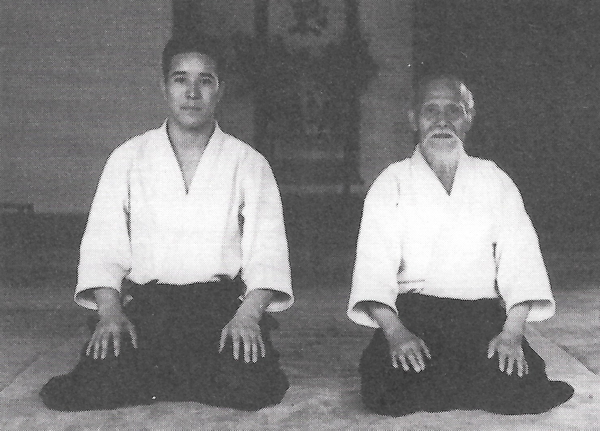 Kenji Shimizu Sensei with Aikido Founder Morihei Ueshiba
Kenji Shimizu Sensei with Aikido Founder Morihei Ueshiba
“You should think of ukemi as being the secret to aikido”. This is my personal experience. During my uchideshi time the founder made me fall without questioning, on top of this I was scolded mercilessly when my ukemi was bad. I had so many painful experiences, that I continuously worried about whether there would be ever any progress, if I would do things like this. Having made it in Judo to the fourth dan grade and thinking I did good ukemi, I doubted that I had to be scolded like this.
But that was a mistake. I had forgotten to put Judo aside and start from zero. I only took my ukemi as I pleased. Yet I was made to become aware of the fact, that my body didn’t move as one with o-sensei’s body. When I think about it now I feel ashamed, that I thought it would be good just to take a showy ukemi.
Ukemi means reading your partner’s breath, and if one will not respond towards the nage (the person who throws) you cannot speak of true ukemi. Mastering ukemi means noticing the signs of your environment, which enables you to deal promptly with the circumstances. The bamboo for examples moves according to the relative strength of the wind, and when the wind stops, the bamboo returns to its original state. That is completely natural and it is alive. In aikido we don’t fight for victory or defeat. It is a way where we improve ourselves through training by repeating the techniques. It is important that you always can correspond with shite (the person, who is executing the technique) whom you are facing. This however is very difficult.
Though it is hard to learn a natural ukemi, an ukemi without force, you have made a huge progress in your technique whenever your body understands a little bit more about it. That may be, because you have learnt to utilize the executing person’s breath power in your own technique. And in my case, I was uke of osensei…
It is important to experience naturally strong techniques. If you cannot do ukemi soft and flexible, it is most likely, that you cannot execute a technique soft and flexible. The natural ukemi in aikido also makes you understand life.
“The Ukemi in Aikido” by Kenji Shimizu
Already an accomplished Judo-ka, Kenji Shimizu (清水健二) Sensei became one of the last uchi-deshi (“live-in student”) of Aikido Founder Morihei Ueshiba in 1963.
After the passing of the Founder he established his own style of Aikido – Tendo-ryu Aikido (天道流合気道), “School of the Way of Heaven”. In 1991 Shimizu Sensei received his eighth dan from the Nihon Kokusai Budoin, and in 2002 was honored by the Japanese foreign minister for spreading knowledge of Aikido as a part of Japanese culture. He travels and teaches extensively in Europe.
He is the author of “Zen and Aikido” (with Shigeo Kamata) and “Aikido: The Heavenly Road“.
This is the second part of a two part interview with Shimizu Sensei that originally appeared in the July and August 2006 issues of Gekkan Hiden (月刊秘伝 / “Secret Teachings Monthly”), a well known martial arts magazine in Japan. You may wish to read Part 1 of the interview before reading this section.
This interview was also published in a collection of interviews with students of the Founder published in Japanese as 開祖の横顔 (“Profiles of the Founder”) in 2009. There was a short introduction to this work in the article “Morihei Ueshiba – Profiles of the Founder“. A number of English translations of interviews from that collection appeared have appeared previously – Nobuyoshi Tamura Sensei (Part 1 | Part 2), Hiroshi Isoyama Sensei (Part 1 | Part 2), Shigenobu Okumura Sensei (Part 1 | Part 2), Nobuyuki Watanabe Sensei (Part 1 | Part 2), Masatake Fujita Sensei (Part 1 | Part 2) , Yoshimitsu Yamada Sensei (Part 1 | Part 2), Kanshu Sunadomari Sensei (Part 1 | Part 2), Hiroshi Kato Sensei (Part 1 | Part 2), Yoshio Kuroiwa Sensei (Part 1 | Part 2) and Morito Suganuma (Part 1 | Part 2).
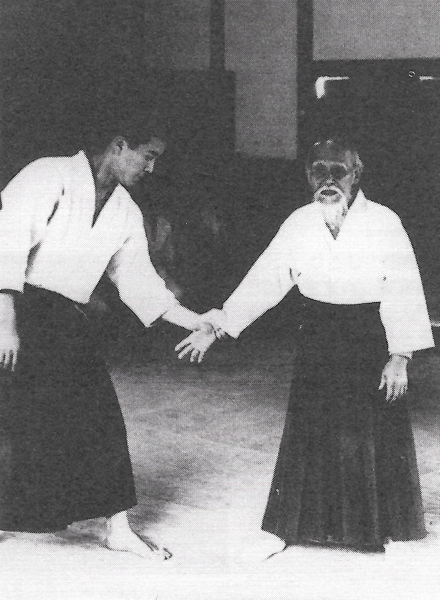 Kenji Shimizu takes ukemi for Aikido Founder Morihei Ueshiba
Kenji Shimizu takes ukemi for Aikido Founder Morihei Ueshiba
Interview with Aikido Shihan Kenji Shimizu – Part 2
Concerning Morihei Ueshiba and Sokaku Takeda
Q: Was there anything else about the Founder than left an impression on you?
A: While doing muna-dori during one demonstration I grabbed O-Sensei’s beard along with his keiko-gi. “Oh no!”, I thought, but he just applied the technique to me calmly. It felt as if he had mastered every applied variation in his skin. Then, O-Sensei had an interest in calligraphy, and at that time it was usually my job to prepare the ink. I would prepare a large quantity of ink, and O-Sensei would apply it to a thick brush and write on a large piece of calligraphy paper – at that time the ink from the brush would often drip down onto the calligraphy paper. But even then O-Sensei would just say “Huh”, gather himself and use it as one part of the character that he was drawing. When he did that the shape of the characters would become unique. Later on a calligraphy specialist saw that and said “That O-Sensei drew it this way must have some kind of meaning…”. As you might expect, I had some mixed feelings when I heard that. I certainly couldn’t say that it was the result of dribbled ink.
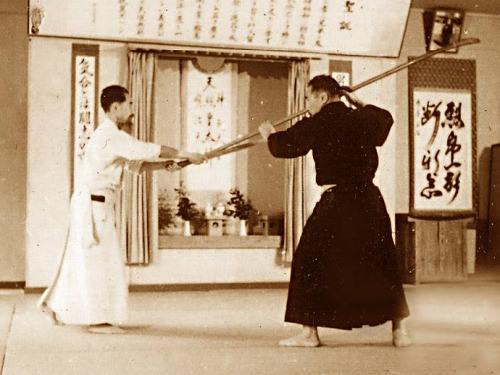 Yoshio Sugino and Minoru Mochizuki training in Tenshin Shoden Katori Shinto-ryu
Yoshio Sugino and Minoru Mochizuki training in Tenshin Shoden Katori Shinto-ryu
I heard this from Minoru Mochizuki Sensei (望月稔) of the Yoseikan (養成館). Long before I became a student there were many high ranking Judo and Kendo practitioners who would come to train, and O-Sensei would criticize Judo and Kendo without compunction. He would even turn towards Kendo students and say “Kendo today is just hitting with a sword”. The former Prime Minister Fumimaro Konoe (近衛文麿) came to train for a time, and one day he finished training and prepared to go home. At the time O-Sensei was with a guest in the reception room and one of the students came to say “His excellency Konoe is leaving”, but O-Sensei just said “Is that so? Well, give him my regards.” and didn’t even stand up from his seat. The guest, surprised, asked “Is it OK if you don’t see him out?”, but O-Sensei said “You are a guest, Konoe-san is a student.”. He certainly had that kind of fiber. There are those today who never actually met O-Sensei who just repeat hearsay, but I bathed with him and we broke bread together. (laughing) According to Mochizuki Sensei, in the beginning of the Showa era (1926-1989) the Kodokan’s Jigoro Kano Sensei gave O-Sensei a look or two. Truthfully, it seems as if he wanted to pull him into the Kodokan, but O-Sensei had already created his own school. So then he directed his own senior students to study under him. Yoshio Sugino Sensei of the Katori Shinto-ryu was also one of those people.
Q: Did you have some interaction with Mochizuki Sensei while he was alive?
A: Yes. During the time that Mochizuki Sensei was the Director (塾頭) of Hombu Dojo he met Sokaku Takeda, and he would often talk about that. Sokaku Sensei came to visit while Mochizuki Sensei was watching the dojo. He seemed like one of those ancient warriors that appear in period novels. He would always carry a sword cane with him when he went out, and he would conceal a knife under the front of his clothing, so his abdomen was covered with cuts. Then, when he went to go home in a taxi after visiting the dojo a wild dog started barking at Sokaku Sensei insistently, and when he hit it with the butt of his sword cane it fell over right there. When Mochizuki Sensei checked he found that it had died instantly. Sugino Sensei also met Sokaku Sensei, and according to him Sokaku Sensei would always check the room before entering – there were times when he made Sugino Sensei open the door for him. It was also difficult when he drank tea, he would always carry tea leaves and a tea cup with him and would just ask for hot water when he was out. When Sugino Sensei prepared the hot water for him he would say “You take a sip”. The point being that he must have been afraid of being drugged or poisoned.
Q: Those must have been normal precautions for ancient warriors.
A: Even in O-Sensei’s case, he wouldn’t stay in the bath long, and wouldn’t display openings carelessly. In any case, he was an extremely cautious person. Perhaps that is something that he learned from Sokaku Sensei.
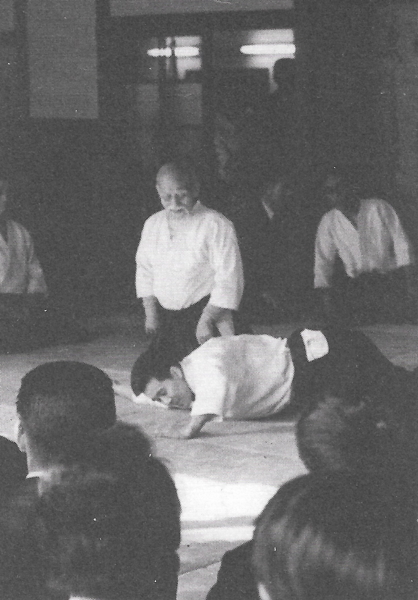 Kenji Shimizu taking ukemi
Kenji Shimizu taking ukemi
Memories of Hombu Dojo
Q: Did the Founder do sword and staff in his later years?
A: No. He almost never did. Most of the time the O-Sensei used a sword or a staff it was for explaining the Riai (理合 – “unified principles”) of Aikido. Because Aikido is not Kendo. We were often taught the Riai of Aiki-ken and Aiki-jo. The demonstrations left an impression on me. There was a demonstration that was given at one place in which O-Sensei carried a folding fan. He gave me a bokken and said “I’ll go easy on you, so come and cut me as strongly as you can!”. In the instant that I tried to strike him as hard as I could I took an atemi to the jaw and flew backwards. It wasn’t anything like “going easy”! (laughing) O-Sensei would often use a folding fan to express yokemen-uchi and tsuki movements. If I had thought that was going to happen then things would have gone differently. At the time, there were many people who came to learn who were from the class of company presidents and politicians. For example, one who was very kind to me was Sunao Sonoda (園田直), who was employed as the Minister of Health, Labour and Welfare and the Minister for Foreign Affairs. Also, Takeo Kimura (木村武雄), who was the right hand man for former Prime Minister Kakuei Tanaka (田中角栄), Tomisaburo Hashimoto (橋本登美三郎) and Toshiki Kaifu (海部俊樹), who would later become Prime Minister, were there. Among those Mr. Sonoda was the first head of the Kokkai Aikikai (国会合気会 – National Diet Aikikai), where I taught for about three years as the first shihan.
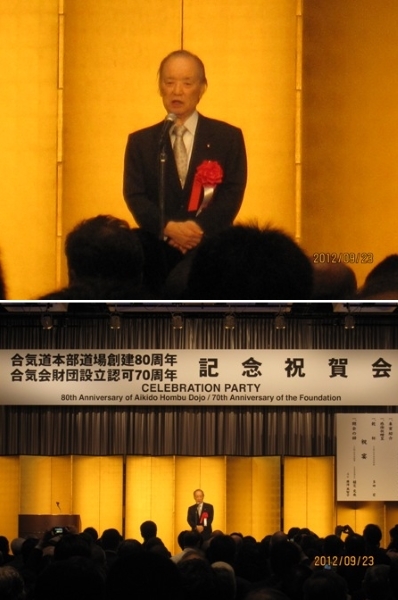 Toshiki Kaifu speaking at the 80th Anniversary of Hombu Dojo,
Toshiki Kaifu speaking at the 80th Anniversary of Hombu Dojo,
the 70th Anniversary of the Aikikai
Also, there was Mr. Shigeru Sahashi (佐橋滋), who was the Administrative Vice‐Minister of International Trade and Industry (通産省事務次官). When Mr. Sahashi was the Administrative Vice‐Minister the Minister of International Trade and Industry (通産大臣) was Mr. Takeo Miki (三木武夫), who would later become Prime Minister (*Translator’s note: Takeo Miki also ran for election as Prime Minister in 1942, against Hideki Tojo), and in the Ministry of International Trade and Industry the Administrative Vice‐Minister was at the top of the career ladder. One time, a bill was passed by Minister Miki’s office, but failed to pass through Vice‐Minister Sahashi’s office. From that time they were called “Minister Sahashi and Vice-Minister Miki” in the Ministry of International Trade and Industry. That Mr. Sahashi wrote just a little bit about his time training with me in the Showa year 44 (1969) issue of Bungeishunju (文芸春秋). Mr. Watanabe, who was a Bureau Chief in the Ministry of International Trade and Industry, and the Giant’s coach Mr. Hiroshi Arakawa would also come to practice often.
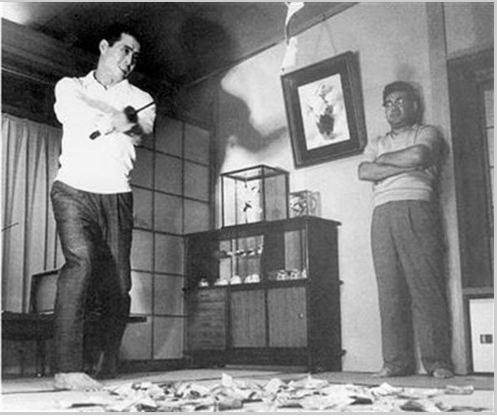 Coach Hiroshi Arakawa watches Sadaharu Oh practice cutting – 1964
Coach Hiroshi Arakawa watches Sadaharu Oh practice cutting – 1964
Q: Who were the uchi-deshi at the time that you enrolled?
A: I don’t have much chance to meet them these days because most of them are now overseas, or for other reasons, but the uchi-deshi at the time were Tamura (Nobuyoshi) Sensei, Saotome (Mitsugi) Sensei, Sasaki (Masando) Sensei, Chiba (Kazuo) Sensei, Imaizumi (Shizuo) Sensei who was was the captain of the Waseda University Aikido club, also Sugano (Seiichi) Sensei, Kurita (Minoru) Sensei and Kanai (Mitsunari) Sensei. There were always about ten uchi-deshi there. In any case, the life of an uchi-deshi is difficult. One is always hungry. Of course, the compensation is small, so in the end one had to hang on to their parent’s legs. My parents wanted me to find another job quickly, and we used to fight about that a lot. When my parents came to Tokyo we took them to some of the better places that we would sometimes go to eat, but my mother said “You eat in places like this?” and broke out in tears. However, it’s said that those who come from hunger build spirit, and we certainly had that. It is said that in the past only those with enough money were be able to become uchi-deshi, so these were really very fine people.
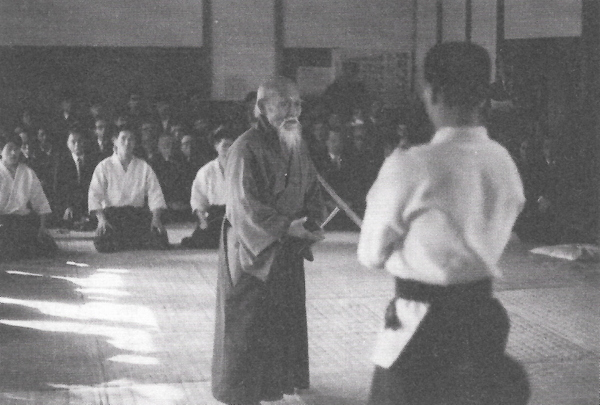 Kenji Shimizu and Morihei Ueshiba around 1965-1966
Kenji Shimizu and Morihei Ueshiba around 1965-1966
Tendo-ryu is “Shimizu Aikido”
Q: Was it from Showa year 45 (1970) that you became independent as Tendo-ryu?
A: Yes, that’s right. That was after O-Sensei passed away. I first I used the name Shimizu Dojo, I rented space from a Judo dojo called Sato Dojo (*Translator’s note: 佐藤道場 – now continued by the children of the original instructor as an osteopathic clinic) in Setagaya Ward. After that I moved to our current location and took the name Tendo-ryu.
Q: Did you have a plan of your own when you became independent?
A: Even if you use the one word “Aikido” there are a lot of variations, aren’t there? Yoshinkan, Tomiki-ryu, even at Aikikai Hombu Dojo the techniques could be quite different depending upon who is instructing. We use he word Aikido as a general term for all of them, but since the content of each of them is different I decided to call my Aikido – “Shimizu Aikido”. In the Bujutsu (Kenjutsu) of the past, it is said that there were more than fifty ryu-ha (schools). The ryu-ha would polish each other, and there there was great progress in Bujutsu. Morihei Ueshiba Sensei was certainly my instructor, but if I have a dojo and teach then it’s my Aikido, isn’t it? That was the reason that I called it Shimizu Dojo when I became independent. After that, it wasn’t that I hid my individual name in order to expand, I thought that a solid ryu-ha should have a name, so I named it “Tendo-ryu”. For that reason, I never consciously changed the techniques. What I was doing were O-Sensei’s techniques, and the foundation was constructed strictly by O-Sensei, but my movements are not the same as O-Sensei’s. My thoughts and physique are different, at any rate it becomes Shimizu’s Aikido. Accordingly, although it is called Tendo-ryu, it has not been altered greatly.
Q: Is there something that you are particular about when it comes to instruction?
A: What I am particular about when it comes to instruction concerns ukemi, as we discussed earlier. For the uke to match their kokyu to the nage is something that is extremely difficult. In Aikido there is kokyu-ho and kokyu-nage, and depending upon the person large individual differences emerge. Well, it can’t be helped that there are skillful people and then those who are not so skillful, those who have the feeling but whose bodies can’t keep up and so forth. For that reason, there are issues that of skillful/unskillful in casual training that can’t be helped. There are those who develop quickly but end up stagnating, and there are those who develop slowly, a little bit at a time. One more thing, I believe that fighting for victory and defeat in training is not good. Since this is Budo, one might think that it looks like fighting to outward appearances, but the reality is different. In the repetition of kata the shite acts as the blade, and the uke must act as the sharpening stone. I believe that it is through that repetition that one becomes tempered. It is my belief that Aikido today is too conscious of strength, it seems as if the techniques are being destroyed. Perhaps one could say that people are “pursuing the strength that can be seen with the eyes”.
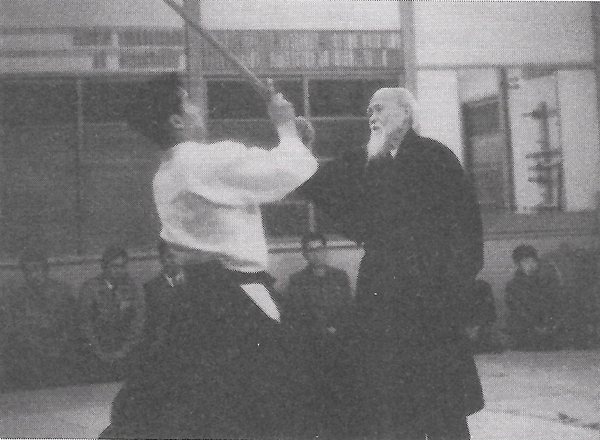 Kenji Shimizu and Morihei Ueshiba around 1965-1966
Kenji Shimizu and Morihei Ueshiba around 1965-1966
The relationship of Shite as the blade, Uke as the sharpening stone
Q: Do you mean that the relationship between the blade and the sharpening stone has been destroyed?
A: Yes, that’s right. If the sharpening stone is uneven then the blade will be uneven as well. When one turns an old bolt, if the bolt is rusty then they apply some oil and turn it a little bit at a time, if one just tries to force it without any oil then it will break. I am fearful of becoming that kind of Aikido. In other words, I am fearful of falling into the delusion that one cannot become strong without applying a technique strongly, of pursuing external strength.
In the case of Aikido, one does not apply technique suddenly, even though one applies it slowly it is effective. I have often experienced attempts of people struggling with each other to apply techniques that will injure the partner. However repetitive kata practice is, I do not think that it is acceptable to injure someone unnecessarily, and if one side resists needlessly the one being resisted will just respond by resisting in turn.
Q: As you said before, the role of the Shite is to act as the blade, and the role of the Uke is to act as the sharpening stone, so will the Uke be able to bring their role as the sharpening stone to fruition if they are not of a higher level than the Shite?
A: There is an important meaning there. For example, during demonstrations Uke becomes able to read the kokyu of the Shite. If that’s not the case then the Shite is simply throwing around someone who is of a lower level then they are, and one is just being thrown around. There are also those who say “The truth is that in Aikido technique one cannot take ukemi”, but it is easy to make it impossible to take ukemi. One just has to apply a technique halfway – but that is a mistake. Controlling the opponent without damaging them is the best. Conversely, when one thinks that it is acceptable to damage the opponent they will not be able to apply their technique on powerful opponents. The reason for this is that once they encounter resistance partway through the technique it’s all over. If one actually tries this then they will understand – if one attempts to use force “I’ll hold you down!” during training then one could say with confidence that the opponent will always sense that and instinctively resist. However, if one applies the technique slowly so that the opponent cannot tell when they will be immobilized, they will be strangely unable to resist. In other words, when there are corners left in one’s movement it won’t be effective on someone who’s a little bit strong. One ought to use a form that protects them against unexpected surprises. In other words, a posture in which one is prepared to destroy the opponent at any time, although controlling them without damage is best. I would like to faithfully preserve these kind of important points that have been passed down to us through the ages.
When training in Budo, what must really become strong is one’s mind. External strength can not be relied upon. In other words, strength that relies on youth is like steel heated in fire – as time passes it becomes cold. However, internal strength is without limit. Strength is limited, the mind is without limit. For that reason, in the past it was through mental training such as zazen that one created “resolve”. Especially when one stood in a position above others, without mental strength nobody would follow them. O-Sensei also said “Real Aikido begins after one is 60 years old. Until one passes 60 the real strength of their spirit does not emerge.”, and now I really understand the meaning of he was saying.
Q: In society, if one says sixty years old they are talking about retirement age, aren’t they?
A: That’s right. But that’s completely backwards. Also, it’s true that there are no competitions in Aikido, but there are certainly diferences in levels. The reason for that is that one can usually learn the basics of Aikido technique in about three years. However, that is still just the entranceway. The problem is from that point forward. While there are those who progress from that point, there are those who just draw a horizontal line, and those who go into a downward curve.
For that reason, it’s not really a problem of how many years one was with some person. What is needed is intensity of training and a willingness to take things in. If one takes things seriously, anyone can progress with certainty.
Q: I see. Thank you for taking time out of your busy schedule to speak with us today. I will pray for the ever-increasing growth of Tendo-ryu.
Gekkan Hiden 2006, July-August
Published by: Christopher Li – Honolulu, HI

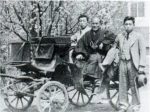




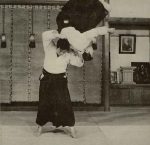
Leave a Reply